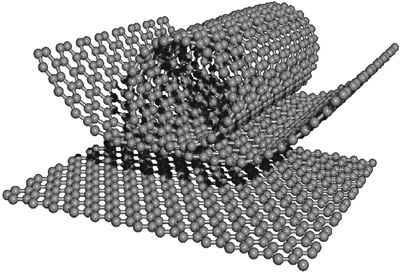Nano cloud capacitor section
Nano supercapacitors and electric current storage properties in (CNT carbon nanotubes) and graphene
Researcher and author: Dr. ( Afshin Rashid)
Note: Because carbon nanotubes are hollow, it is possible to put foreign materials inside them. So, by placing metals inside it, both electrical properties can be improved and energy storage can be done.
The stringed nano supercapacitor has the possibility of both current passing and energy storage. Copper wire and plastic nanoscale layers have been used to make this string. So far, cables and wires have been used to store electricity. But a string of light copper nanowires can store energy in addition to transmitting electricity. A nanostructure is used for conduction and storage. Such a wire can be used inside CNT single-layer nanotubes to store current. Copper nanowires are a nanoscale sheath. And this sheath is combined with a special alloy and finally creates an electrode.
Supercapacitors need another electrode for storage. For this, a thin plastic layer is placed on the surface of the sheath and covered with another metal . A special gel is also used to connect these layers together. Due to the existence of the insulating nano layer, in supercapacitors, the inner wire string can play the role of current transmitter and the external electrode provides the possibility of storage independently . In this case, a supercapacitor made of copper is produced, which has the possibility of both current passing and storage. Thomas believes that such a supercapacitor can be produced with other materials. The energy storage and electrical conductivity of nanotube cables can be as high as the conductivity of metal wires, among compounds Differently used in supercapacitors, graphene-based materials, especially three-dimensional graphene, facilitate the way for electrolyte penetration and increase energy storage due to its unique three-dimensional structure . Also, high electrical conductivity and large surface area are among other advantages of this type of three-dimensional porous structures, which have found potential for application in nano-supercapacitors.
One of the ways to optimize the properties of energy storage systems is to develop new materials for use as electrode materials in nano supercapacitors. Carbon materials such as graphene, carbon nanotubes, graphite, carbon nanofibers, etc., play an important role in nanosupercapacitors due to their good electrical conductivity, cheapness, availability, biocompatibility, and good chemical stability. Carbon structures are three-dimensional graphene, which facilitates the penetration of electrolyte due to its unique three-dimensional structure and has a large surface area and high electrical conductivity.
Conclusion :
Nano supercapacitors are also very similar to capacitors in terms of structure and mechanism (on the nanoscale), with the difference that the surface area of the electrodes is larger due to the many pores in the supercapacitor, which leads to an increase in the energy storage capacity in the supercapacitor. compared to ordinary capacitors. The energy density of nano supercapacitors is much higher than the usual dielectric capacitors.
Researcher and author: Dr. ( Afshin Rashid)
Specialized doctorate in nano-microelectronics





